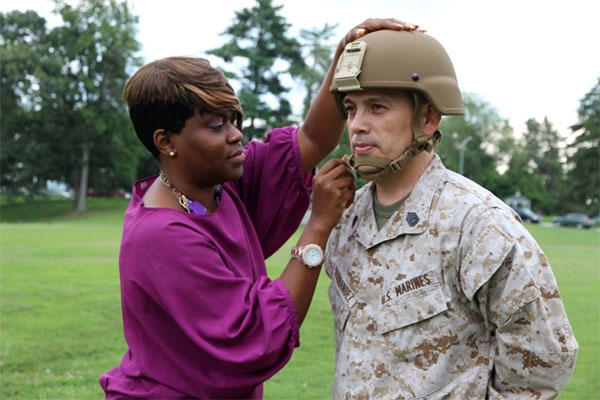Beginning this fall, the Army and Marine Corps will begin issuing a new helmet designed to protect against rifle bullets.
After four years of developmental hurdles, both services will field the first of thousands of Enhanced Combat Helmets to deploying troops after the Oct. 1 start of fiscal 2014.
Marine Corps Systems Command announced the fielding July 30. When contacted, the Army's Program Executive Office Soldier also confirmed it will begin fielding the ECH this fall, said PEO Soldier spokesman Alton Stewart.
The new helmet is made of an Ultra-High Molecular Weight Polyethylene, a lightweight material that provides a higher degree of protection than Kevlar and Twaron used Army's current Advanced Combat Helmet and the Marine Lightweight Helmet without adding any additional weight.
"This helmet is above and beyond," Kathy Halo, ECH lead engineer, said in a Marine Corps Systems Command release. "The ECH fully exploits the latest lightweight material technology. … It provides increased small-arms ballistic protection above what is currently provided by the Lightweight and Advanced Combat helmets."
So instead of protecting against 9mm ammunition and shell fragments, the new ECH is capable of stopping higher-velocity rifle rounds commonly used by enemy forces, program officials maintain.
The Army and the Marines tapped Ceradyne Inc., to make the ECH in March 2012. It's unclear how long it will take the services to field the ECH, but Army officials have said the service plans to buy at least 200,000 of the new helmets while the Marines intend to buy 38,500.
The announcement is a significant leap ahead in protection, but the joint program has suffered its share of setbacks.
None of the initial design candidates for ECH passed the first round of ballistic testing in late 2009. Then some of the ECHs began failing "first article tests" in 2011.
The ECH is the only helmet that has been tested and passed using Director of Operational Test and Evaluation protocols, said Deidre Hooks, ECH team lead at Marine Corps Systems Command. Following the DOT&E protocols was a challenge because test criteria changed from a pass-fail standard to one based on statistical confidence, Halo said.
"One of the biggest challenges was the change in statistical methodology in the midst of the helmet testing," Halo said.
In typical equipment test and development, successful first-article testing certifies the product meets standards detailed in the original statement of work. This leads to a contract award that starts initial production. This leads to full-rate production with successful acceptance testing and fielding.
Even before the pass-fail ECH tests were complete, DOT&E introduced a new statistical protocol. Under these criteria, the ECH had to attain a 90 percent probability with 90 percent confidence that the helmet will not be penetrated, according to Col. Mike Manning, program manager for Infantry Weapons Systems at Marine Corps Systems Command.
Having passed first-article tests using DOT&E's original criteria, the ECH team turned around and proved through additional testing that the helmet could meet the revised standards, Hooks said.
"We identified anomalies on the production line after the final first-article test was complete," Manning said. "We fixed it, and now we're ready for production. We met every requirement of every test we've been asked to meet. I'd wear the ECH in a heartbeat."






























